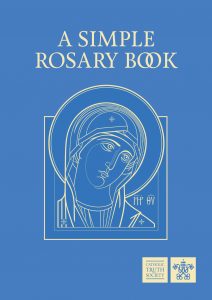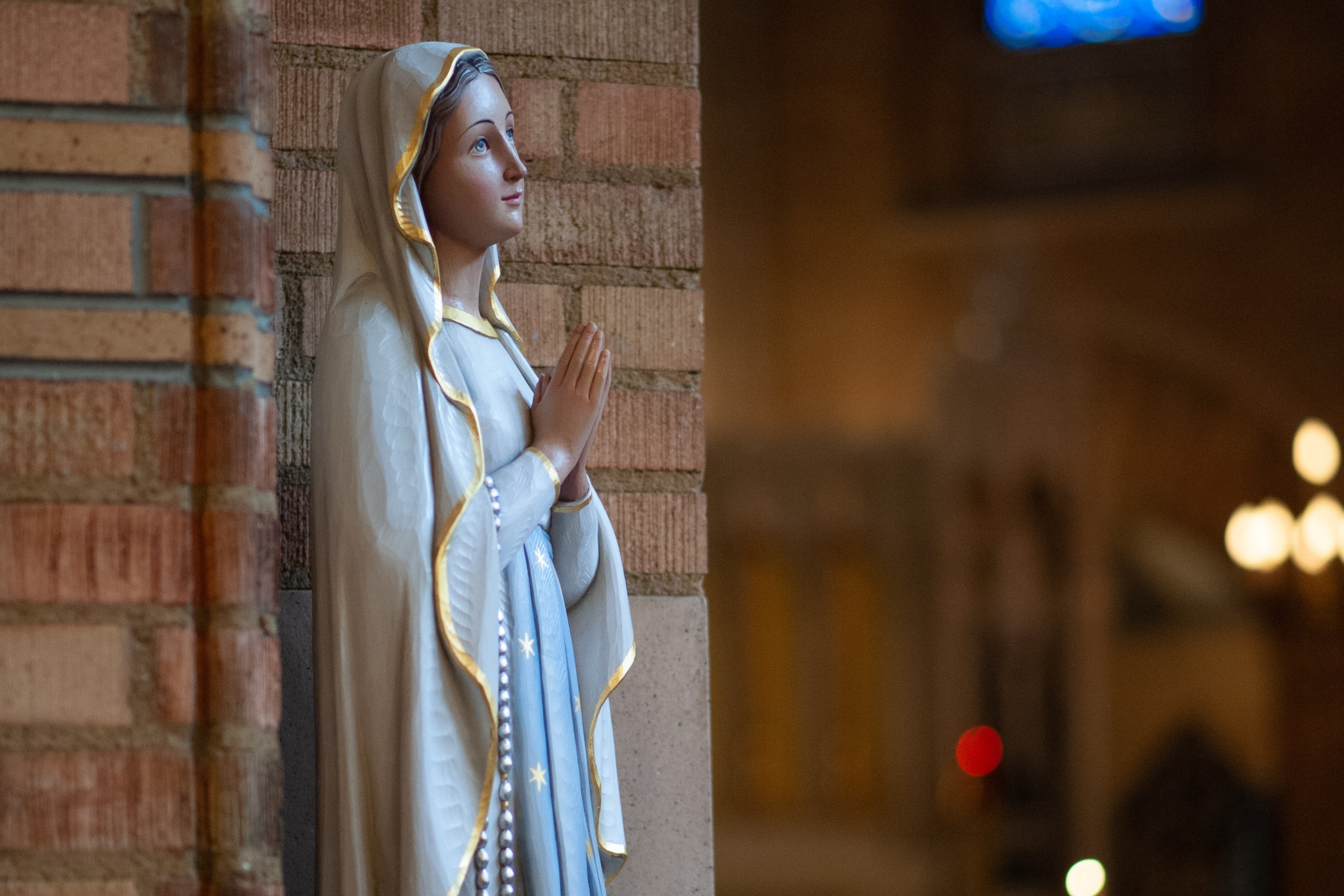The Rosary, though clearly Marian in character, is at heart a prayer with Christ at the centre. It contains all the depth of the Gospel message in its entirety. With the Rosary we sit at the school of Mary and are led to contemplate the beauty of the face of Christ and to experience the depths of his love. Through the Rosary the faithful receive abundant grace, as though from the very hands of the Mother of the Redeemer.
To recite the Rosary is nothing other than to contemplate with Mary the face of Christ. The Rosary, reclaimed in its full meaning, goes to the very
heart of Christian life; it offers a familiar yet fruitful spiritual and educational opportunity for personal contemplation, the formation of the People of God, and the new evangelisation. A prayer so easy and yet so rich truly deserves to be rediscovered by the Christian community – may we confidently take up the Rosary again, rediscover it in the light of Scripture, in harmony with the Liturgy, and in the context of our daily lives.
The Rosary is undervalued
There is in our time a great risk that the Rosary is undervalued and no longer taught to the younger generation. Some erroneously think that the centrality of the Liturgy necessarily entails giving less importance to the Rosary. But this prayer does not conflict with the Liturgy, but rather sustains it, serving as an excellent introduction to and echo of the Liturgy, enabling people to participate fully and interiorly in it and to reap its fruits in their daily lives. Nor is such a devotion, so clearly directed to the Christological centre of the Christian faith, to be considered as unecumenical – properly revitalised it is an aid and no hindrance to ecumenism.
A school of prayer
The most important reason for strongly encouraging the practice of the Rosary is that it represents a most effective means of fostering among the faithful that commitment to the contemplation of the Christian mystery, a genuine ‘training in holiness’: what is needed in a Christian life distinguished above all in ‘the art of prayer’. The West is now experiencing a renewed demand for meditation, and in effect the Rosary is simply a method of contemplation, it serves as a means to an end and cannot become an end in itself, though never undervalued all the same. The Rosary is one of the finest traditions to have grown out of Christian contemplative prayer in the Christian West, comparable to the famous ‘prayer of the heart’ or ‘Jesus prayer’ of the Christian East.
Praying for peace and the family
Reviving the Rosary is important because of the great contemporary need to implore God for peace, by looking on Christ “who broke down the dividing wall of hostility”. Anyone who assimilates the mystery of Christ – and this is clearly the goal of the Rosary – learns the secret of peace and makes it his life’s project, giving birth to fruits of charity. The Rosary also makes of us peacemakers.
Such a revival in Christian families will also be an effective aid to countering the devastating effects of the menacing forces of disintegration playing on the institution of the family – so indispensable to the future of society. The family that prays together stays together. This is so true of the Rosary, which keeps alive lines of communication within families, where Jesus is placed at the centre. Even Mary herself, in the apparitions at Lourdes and Fatima exhorts us to make recourse to this prayer.
It is also beautiful and fruitful to entrust to this prayer the growth and development of children. Given the great range and gravity of seductions to be resisted by children today, the spiritual aid of praying the Rosary for children and even more with children, should not be underestimated.
Learning from Mary
The aim of the Rosary is to contemplate the face of Christ and no one has ever been devoted to contemplating the face of Christ as faithfully as Mary. Through the Rosary, we remember Christ with Mary, and ‘learn Christ’ from Mary. She was with Christ throughout his life, she carried him in her womb, brought him into the world in the stable, watched him grow up, preach, perform miracles, suffer and die and finally conquer death in the resurrection. She is the greatest and most perfect guide for us to the life of Jesus.
Saving power of the mysteries
Mary lived with her eyes fixed on Jesus, treasuring his every word, kept them and pondered them in her heart. The memories of Jesus, impressed on her heart, were always with her, leading her to reflect on the various moments of her life at her Son’s side. In a way those memories were to be the ‘rosary’, which she recited uninterruptedly throughout her earthly life. Mary constantly sets before us the ‘mysteries’ of her Son, with the desire that the contemplation of those mysteries will release all their saving power. In the recitation of the Rosary, the Christian community enters into contact
with the memories and the contemplative gaze of Mary. Precisely because it starts with Mary’s own experience, the Rosary is an exquisitely contemplative prayer. Without this contemplative dimension it would lose its meaning.
Mary’s contemplation is above all a remembering, in the sense of ‘a making present’ of the works brought about by God in the history of salvation – to ‘remember’ them in a spirit of faith and love is to be open to the grace which Christ won for us by the mysteries of his life, death and resurrection. The Rosary in its own way too is part of the varied panorama of ‘ceaseless prayer’ called for by the great apostle Paul. By immersing us in the mysteries of the Redeemer’s life, the Rosary ensures that what he has done and what the Liturgy makes present is profoundly assimilated and shapes our existence.
Being conformed to Christ
Christ is the supreme teacher, the revealer and the one revealed. It is not just a question of learning what he taught but of ‘learning him’. In this regard we could have no better teacher than Mary. Contemplating the scenes of the Rosary in union with Mary is a means of learning from her to ‘read’ Christ, to discover his secrets and to understand his message. As we contemplate each mystery of her Son’s life, she invites us to do as she did
at the Annunciation; to ask humbly the questions which open us to the light, in order to end with the obedience of faith: Behold I am the handmaid of the Lord; be it done to me according to your word.
In the spiritual journey of the Rosary, based on the constant contemplation – in Mary’s company – of the face of Christ, this demanding ideal of being conformed to him is pursued through an association, which could be described in terms of friendship. We are enabled to enter naturally into Christ’s life and as it were to share his deepest feelings. In this process of being conformed to Christ in the Rosary, we entrust ourselves in a special way to the maternal care of the Blessed Virgin – she who is the perfect icon of the motherhood of the Church.
If Jesus, the one Mediator, is the Way of our prayer, then Mary, his purest and most transparent reflection, shows us the Way. In the Gospel, at Cana, we see the power of Mary’s intercession as she makes known to Jesus the needs of others: “They have no wine”. The Rosary is both meditation and supplication. Insistent prayer to the Mother of God is based on confidence that her maternal intercession can obtain all things from the heart of her Son.
Rhythm of the Rosary
By its nature the recitation of the Rosary calls for a quiet rhythm and a lingering pace, helping the individual to meditate on the mysteries of the Lord’s life as seen through the eyes of her who was closest to the Lord. This is especially so when the Rosary is seen as an outpouring of that love which tirelessly returns to the person loved. Not only does Christ have a divine heart, rich in mercy and forgiveness, but also a human heart, capable of stirrings of affection. Although the repeated Hail Mary is addressed to Mary, it is to Jesus that the act of love is ultimately directed, with her and through her – and nourished by a desire to be conformed ever more completely to Christ.
 This blog is exracted from A Simple Rosary Book. Designed for those familiar with the prayer as well as for newcomers, this text clearly explains how to pray the Rosary. Prayers and Scripture passages associated with the Rosary are also included.
This blog is exracted from A Simple Rosary Book. Designed for those familiar with the prayer as well as for newcomers, this text clearly explains how to pray the Rosary. Prayers and Scripture passages associated with the Rosary are also included.
Support the mission of CTS and learn more about the rosary, by ordering your copy of A Simple Rosary Book here.
